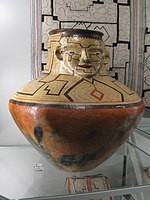Approximants are speech sounds that involve the articulators approaching each other but not narrowly enough nor with enough articulatory precision to create turbulent airflow. Therefore, approximants fall between fricatives, which do produce a turbulent airstream, and vowels, which produce no turbulence. This class is composed of sounds like and semivowels like and, as well as lateral approximants like.

The voiced retroflex flap is a type of consonantal sound, used in some spoken languages. The symbol in the International Phonetic Alphabet that represents this sound is ⟨ɽ⟩, and the equivalent X-SAMPA symbol is r`.

The voiced velar approximant is a type of consonantal sound, used in some spoken languages. The symbol in the International Phonetic Alphabet that represents this sound is ⟨ɰ⟩, and the equivalent X-SAMPA symbol is M\.
The phonology of Portuguese varies among dialects, in extreme cases leading to some difficulties in intelligibility. Portuguese is a pluricentric language and has some of the most diverse sound variations in any language. This article on phonology focuses on the pronunciations that are generally regarded as standard. Since Portuguese is a pluricentric language—and differences between European Portuguese (EP), Brazilian Portuguese (BP), and Angolan Portuguese (AP) can be considerable—varieties are distinguished whenever necessary.
Martuthunira is an extinct Australian Aboriginal language, that was the traditional language of the Martuthunira people of Western Australia.

Panoan is a family of languages spoken in western Brazil, eastern Peru, and northern Bolivia. It is possibly a branch of a larger Pano–Tacanan family.
Urhobo is a South-Western Edoid language spoken by the Urhobo people of southern Nigeria.
Ndrumbea, variously spelled Ndumbea, Dubea, Drubea and Païta, is a New Caledonian language that gave its name to the capital of New Caledonia, Nouméa, and the neighboring town of Dumbéa. It has been displaced to villages outside the capital, with fewer than a thousand speakers remaining. Gordon (1995) estimates that there may only be two or three hundred. The Dubea are the people; the language has been called Naa Dubea "language of Dubea".
The Kaingang language is a Southern Jê language spoken by the Kaingang people of southern Brazil. The Kaingang nation has about 30,000 people, and about 60–65% speak the language. Most also speak Portuguese.
The Kukuya language, Kikukuya[kìkýkȳā], also transcribed Kukẅa and known as Southern Teke, is a member of the Teke dialect continuum of the Congolese plateau. It is the only language known to have a phonemic labiodental nasal. The name of the language comes from the word kuya "plateau".
Kensiu (Kensiw) is an Austro-asiatic language of the Jahaic subbranch. It is spoken by a small community of 300 in Yala Province in southern Thailand and also reportedly by a community of approximately 300 speakers in Western Malaysia in Perak and Kedah States. Speakers of this language are Negritos who are known as the Mani people or Maniq of Thailand.
The nasal palatal approximant is a type of consonantal sound used in some oral languages. The symbol in the International Phonetic Alphabet that represents this sound is ⟨j̃⟩, that is, a j with a tilde. The equivalent X-SAMPA symbol is j~, and in the Americanist phonetic notation it is ⟨ỹ⟩.
The nasal labial–velar approximant is a type of consonantal sound used in some languages. The symbol in the International Phonetic Alphabet that represents this sound is ⟨w̃⟩, that is, a w with a tilde. The equivalent X-SAMPA symbol is w~.

Siona is a Tucanoan language of Colombia and Ecuador. The language is essentially the same as Secoya, but speakers are ethnically distinct.
Jebero is a moribund Amazonian language spoken by the Jebero people of Jeberos, Peru. It is spoken by only a small number of older adults and belongs to the Cahuapanan family together with Chayahuita.
The phonology of Faroese has an inventory similar to the closely related Icelandic language, but markedly different processes differentiate the two. Similarities include an aspiration contrast in stop consonants, the retention of front rounded vowels and vowel quality changes instead of vowel length distinctions.
Ojitlán Chinantec is a major Chinantecan language of Mexico, spoken in four towns in San Lucas Ojitlán of northern Oaxaca, and in the Veracruz municipos of Minatitlán and Hidalgotitlán.
Iduna is an Austronesian language spoken on Goodenough Island of Milne Bay Province of Papua New Guinea.
The voiced bilabial affricate is a rare affricate consonant that is initiated as a bilabial stop and released as a voiced bilabial fricative. It has not been reported to occur phonemically in any language.






